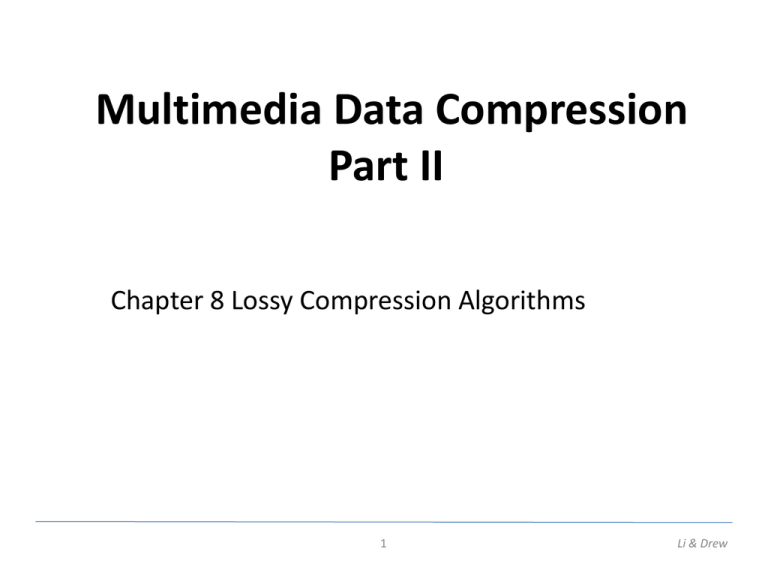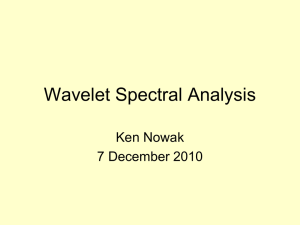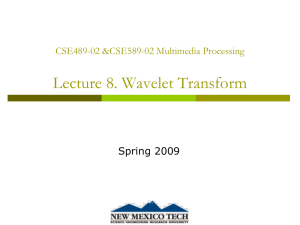Chapter 7 Lossless Compression Algorithms
advertisement

Multimedia Data Compression
Part II
Chapter 8 Lossy Compression Algorithms
1
Li & Drew
Chapter 8
Lossy Compression Algorithms
8.1 Introduction
8.2 Distortion Measures
8.3 The Rate-Distortion Theory
8.4 Quantization
8.5 Transform Coding
8.6 Wavelet-Based Coding
Fundamentals of Multimedia, Chapter 7
8.1 Introduction
• Lossless compression algorithms do not deliver
compression ratios that are high enough. Hence,
most multimedia compression algorithms are
lossy.
• What is lossy compression?
– The compressed data is not the same as the original
data, but a close approximation of the original image
perceptually.
– Yields a much higher compression ratio than that of
lossless compression.
3
Li & Drew
Fundamentals of Multimedia, Chapter 7
8.2 Distortion Measures
• A distortion measure is a mathematical quantity that specifies how close an
approximation is to its original, using some distortion criteria.
• The three most commonly used distortion measures in image compression are:
N
– mean square error (MSE) σ2,
2
1
(
x
y
)
n
n
N
n
1
2
(8.1)
where xn, yn, and N are the input data sequence, reconstructed data sequence,
and length of the data sequence respectively.
x2
R1
0lo
g
– signal to noise ratio (SNR), in decibel units (dB), SN
(8.2)
1
0
d2
where
the MSE.
2
x
is the average square value of the original data sequence and
d
2
is
2
x
p
e
a
k
– peak signal to noise ratio (PSNR),
P
S
N
R
1
0
lo
g
1
0
4
2
d
(8.3)
Li & Drew
Fundamentals of Multimedia, Chapter 7
8.3 The Rate-Distortion Theory
• Provides a framework for the study
of tradeoffs between Rate and
Distortion.
• Rate is: the average number of bits
required to represent each source
symbol.
• From figure: the minimum possible
rate at D=0, no loss. The distortion
corresponding to a rate R(D)=0 is
the maximum amount of distortion
incurred when “nothing” is coded.
5
Li & Drew
Fundamentals of Multimedia, Chapter 7
8.4 Quantization
• Reduce the number of distinct output values to a
much smaller set.
• Main source of the “loss” in lossy compression.
• Three different forms of quantization.
– Uniform: midrise and midtread quantizers.
– Nonuniform: companded quantizer.
– Vector Quantization.
6
Li & Drew
Fundamentals of Multimedia, Chapter 7
8.5 Transform Coding
• The rationale behind transform coding:
If Y is the result of a linear transform T of the input vector X in
such a way that the components of Y are much less correlated,
then Y can be coded more efficiently than X.
• If most information is accurately described by the first few
components of a transformed vector, then the remaining
components can be coarsely quantized, or even set to zero, with
little signal distortion.
• Transformation to the frequency domain via Discrete Cosine
Transform (DCT), Wavelet Transform (WT) and Fourier Transform
(FT).
7
Li & Drew
Fundamentals of Multimedia, Chapter 7
Spatial Frequency and DCT
• Spatial frequency indicates how many times pixel values
change across an image block.
• The DCT formalizes this notion with a measure of how
much the image contents change in correspondence to
the number of cycles of a cosine wave per block.
• The role of the DCT is to decompose the original signal
into its DC and AC components; the role of the IDCT is
to reconstruct (re-compose) the signal.
8
Li & Drew
Fundamentals of Multimedia, Chapter 7
Fig. 8.9: Graphical Illustration of 8 × 8 2D DCT basis.
9
Li & Drew
Fundamentals of Multimedia, Chapter 7
8.6 Wavelet-Based Coding
• The objective of the wavelet transform is to decompose the input
signal into components that are easier to deal with, have special
interpretations, or have some components that can be thresholded
away, for compression purposes.
• We want to be able to at least approximately reconstruct the original
signal given these components.
• The basis functions of the wavelet transform are localized in both
time and frequency.
• There are two types of wavelet transforms: the continuous wavelet
transform (CWT) and the discrete wavelet transform (DWT).
10
Li & Drew
Fundamentals of Multimedia, Chapter 7
Wavelet Transform Example
•
Suppose we are given the following input sequence.
{xn,i} = {10, 13, 25, 26, 29, 21, 7, 15}
•
Consider the transform that replaces the original sequence with its
pairwise average xn−1,i and difference dn−1,i defined as follows:
x n 1, i
d n 1, i
•
x n ,2 i x n ,2 i 1
2
x n ,2 i x n ,2 i 1
2
The averages and differences are applied only on consecutive pairs of
input sequences whose first element has an even index. Therefore, the
number of elements in each set {xn−1,i} and {dn−1,i} is exactly half of the
number of elements in the original sequence.
11
Li & Drew
Fundamentals of Multimedia, Chapter 7
• Form a new sequence having length equal to that of the
original sequence by concatenating the two sequences
{xn−1,i} and {dn−1,i}. The resulting sequence is
{xn−1,i, dn−1,i} = {11.5, 25.5, 25, 11,−1.5,−0.5, 4,−4}
• This sequence has exactly the same number of elements as
the input sequence — the transform did not increase the
amount of data.
• Since the first half of the above sequence contain averages
from the original sequence, we can view it as a coarser
approximation to the original signal. The second half of this
sequence can be viewed as the details or approximation
errors of the first half.
12
Li & Drew
Fundamentals of Multimedia, Chapter 7
• It is easily verified that the original sequence can be reconstructed from the
transformed sequence using the relations
xn, 2i = xn−1, i + dn−1, i
xn, 2i+1 = xn−1, i − dn−1, i
• This transform is the discrete Haar wavelet transform.
Fig. 8.12: Haar Transform: (a) scaling function, (b) wavelet function.
13
Li & Drew
Fundamentals of Multimedia, Chapter 7
2D Wavelet Transform
• For an N by N input image, the two-dimensional DWT proceeds as follows:
– Convolve each row of the image with low-pas and high-pass filters, discard
the odd numbered columns of the resulting arrays, and concatenate them
to form a transformed row.
– After all rows have been transformed, convolve each column of the result with
low-pass and high-pass filters. Again discard the odd numbered rows and
concatenate the result.
• After the above two steps, one stage of the DWT is complete. The transformed
image now contains four subbands LL, HL, LH, and HH, standing for low-low,
high-low, etc.
• The LL subband can be further decomposed to yield yet another level of
decomposition. This process can be continued until the desired number of
decomposition levels is reached.
14
Li & Drew
Fundamentals of Multimedia, Chapter 7
Fig. 8.19: The two-dimensional discrete wavelet transform
(a) One level transform, (b) two level transform.
15
Li & Drew
Fundamentals of Multimedia, Chapter 7
2D Wavelet Transform Example
16
Li & Drew











